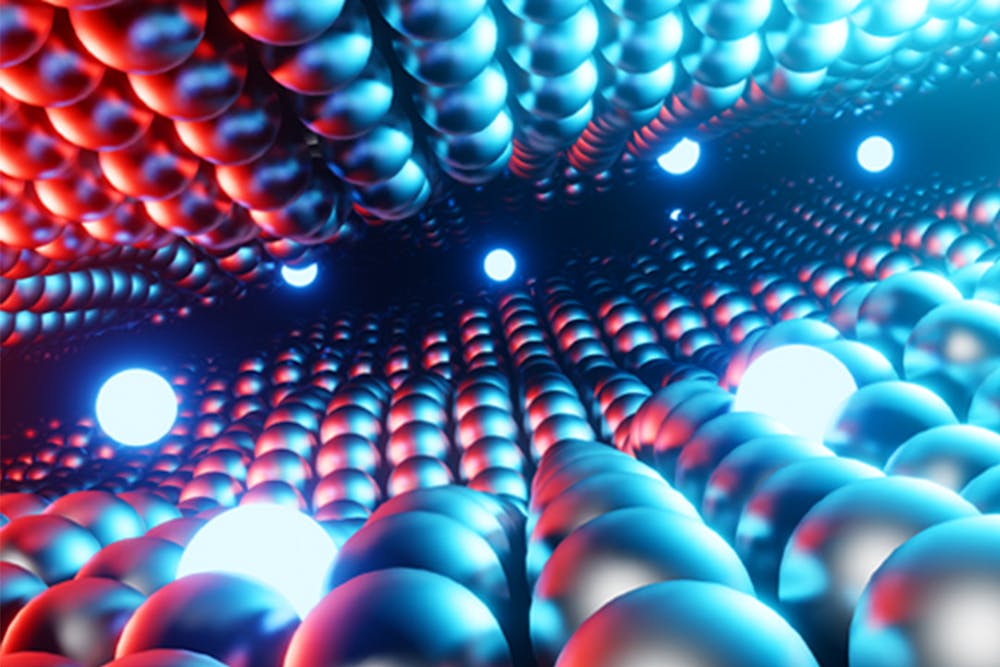Nanomaterials, which are materials with structures and properties with sizing at the scale of nanometers, have emerged as the vanguard of innovation, promising groundbreaking applications across diverse industries such as electronics, refrigeration and space exploration. A nanometer, for scale, is about how long a human fingernail grows in one second.
Among the pioneers in this frontier of scientific exploration is Birkel Lab, a hub of cutting-edge research dedicated to crafting new materials with unique potentials. This includes layered solids, which are composites of different compounds in individual layers.
"We're very interested in layered solids. And so, some of our most recent breakthroughs, I would say, are making new types of layered solids that belong to the family of MAX phases," Christina Birkel, associate professor in the School of Molecular Sciences, said.
One of Birkel Lab's primary focuses has been the development of novel layered solids, with a special emphasis on materials falling under the MAX phases category, which indicates certain chemical formulas that are more prone to stability.
Magnetism is a fascinating property that has captured the lab's attention. Extensive work on the low-temperature magnetic properties of nanomaterials is underway, especially considering the property of magnets to heat or cool themselves under magnetic field changes, also known as the magnetocaloric effect.
"We have recently made a material that would be an interesting, potentially magnetocaloric material, which means you can use it for solid state cooling," Birkel said. "Magnetocaloric refrigeration would be a very, very interesting, very far in the future, goal."
This innovative cooling technology could transform the way we think about energy-efficient cooling and cooling in buildings, while it will make refrigeration much easier while producing less waste.
Dedication to responsible innovation means selecting eco-abundant elements for materials.
"(Another) aspect is sustainability, and this is one of the big focus areas now for many different projects and for many different research groups," Birkel said. "One thing that I can say for our materials is that they contain more sustainable elements, for example, so we like to stay away from rare earth elements … (such as) cobalt."
Whether it's in construction, where weather-resistant and long-lasting building materials are essential, or in the realm of space exploration, where materials must withstand extreme conditions, the requirement for robust structural integrity remains constant.
"If you're thinking about real-life applications, you have to worry about moisture, you have to worry about high temperatures, especially in an area like this," Birkel said. "And maybe you even want to get crazy and you want to maybe use one of the materials in space ... then you need the materials to have a certain structural and mechanical stability."
Two other projects currently in development at the Birkel Lab include sol-gel, a gelatinous mix of inorganic and organic materials and solid-state material synthetization.
"Sol-Gel chemistry offers exciting possibilities for applications, from energy storage to electronics," Jordan Sinclair, a PhD student at Birkel Lab who specializes in utilizing sol-gel chemistry to create crystalline materials, said. He works on tailoring MAX phases' properties for various applications.
"In solid-state chemistry, we 'shake and bake' MAX phases, fine-tuning compositions for diverse applications," Arya Loloee, a PhD student at Birkel Lab, said. Loloee focuses on mixing metal and arsenic powders to synthesize MAX phases.
However, pushing the boundaries of material science and innovation does not come without a fair share of challenges. In the quest to discover new materials and harness their unique properties, Birkel Lab encounters various obstacles.
"The real problem that comes to sol-gel is ... we have no real way of getting rid of impurities in the end product," Sinclair said.
This is a common hurdle in materials synthesis, where impurities can significantly impact the final product's properties. On the solid-state side of things, timing is an obstacle.
"(The) issue that I have is how long it takes to synthesize things," Loloee said. "So like, when I put something in the furnace, I have to wait for the furnace to heat up to (the) temperature that I want it to, and I have to hold it for 48 hours."
In the pursuit of groundbreaking materials and innovative solutions, researchers like those at Birkel Lab must navigate the intricate balance of time, precision and variability. These challenges, while demanding, ultimately contribute to the lab's growth and the advancement of the field. The obstacles they have faced have not stopped them from incredible discoveries.
Birkel Lab demonstrates that the fusion of creativity, scientific rigor and sustainable principles can pave the way for a brighter and more innovative future.
Edited by River Graziano, Sadie Buggle and Grace Copperthite.
Reach the reporter at dmanatou@asu.edu.
Like The State Press on Facebook and follow @statepress on X.
Dimitra is a junior studying biomedical engineering and physics. This is her second semester with The State Press. She has also worked as a research assistant in Kirian Lab.




